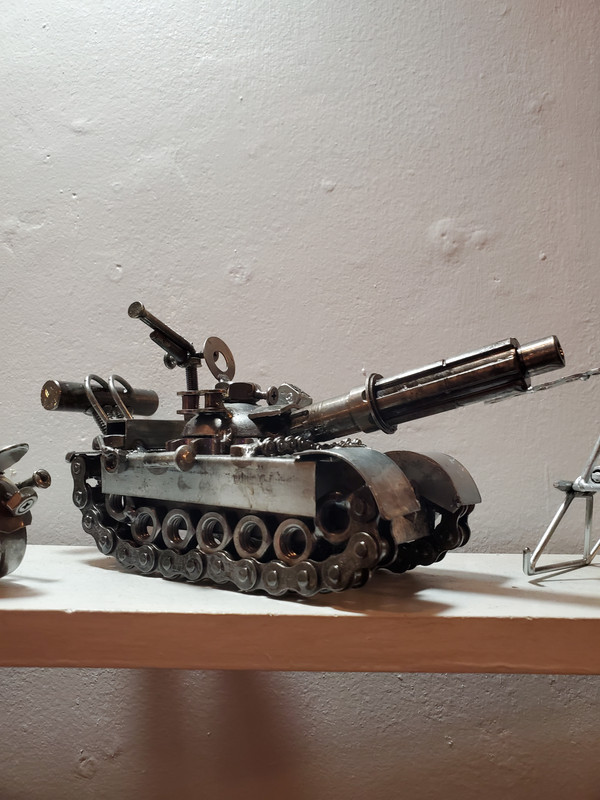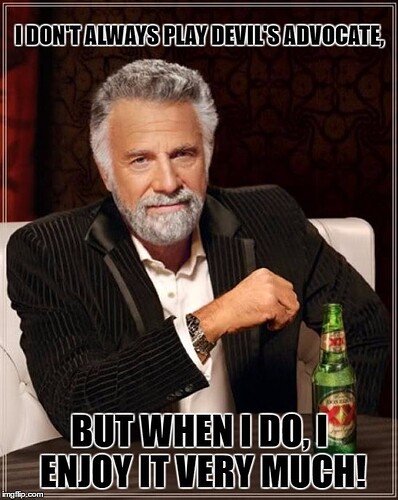Was she really holding it in though?
Maybe she had just let it sneak out and was smiling that cunning
smirk of “I just did something bad and you haven’t noticed yet …nana-nana-nanahh”
I’ve seen model kit sprues spraypainted and used as art sculptures in art galleries, but I have never seen a scale model kit in an art gallery being sold as art. I mean, heck, anyone can gather a bunch of used empty sprues, superglue them all together, create a jumbled mess, spray paint it a primary color and call that “Art.” But few have the patience, skills, time and effort, and monetary resources to build a near-flawless model kit well by following instructions. And the ironic thing is that in the art galleries, the signs—DO NOT TOUCH THE ART—seems to be about sculptures and art more robust than the built model kits at the model contests that also have the DO NOT TOUCH signs.
I’ve seen cheap model kits being sold at drug stores and art stores, but hardly the proper paints, tools, and supplies to produce a decent built model kit. Since the 1980s (or even before), Testors has supported the art and drug stores’ very small model kit sections. Veteran, experienced, and knowledgeable modelers don’t use that Testors (little enamel glass jars) paint line and Testors brush supplies at the art and drug stores. That is like a cheap and “bad” introduction to the hobby. ![]()
And notice that many hobby stores have closed? If modeling is a true form of art, then why is it not supported with more hobby stores and better supported in the art stores? That is because model kit building is often considered a “throw away” art form in the end—it has no real monetary value—built kits cannot be sold (well) because they are considered too fragile. Sure, people want built kits for FREE because the level and skills vary so much for the same kits being built. But a $20 offer for a built kit when the unassembled kit costs $60 is like an insult to the builder.
However, the used sprues we consider junk and throw away or recycle do end up in the art galleries as “sculpture” to sell for hundreds to thousands of dollars…but not built model kits. Go figure…
Dont thrash those sprues,
paint them and sell them
![]()
![]()
@Uncle-Heavy Yup! And the art gallery was very near the city’s main shopping district pre-COVID-19. I’m not sure if the art gallery survived the pandemic though…or the artist.
I think “art” is a catch-all term that is open to wide conjecture.
For me, the art of modelling is in the aesthetic and understanding basic colours and composition. This is art theory that you apply to the assembly of styrene parts off a molding sprue with glue and a knife.
The theory applies in so far as you are able to take those parts and make a likeness of an object. Some choose to sidestep all art and go for realism at any cost which has an aesthetic of its own in a way.
Others choose to make an artistic representation of the real thing with commensurate artistic license taken to make a model more visually appealing, sometimes at the expense of a degree of realism.
I believe most modellers are able sit between these two poles and different builds can sit on this scale in different positions.
For example colour modulation. We do it to add visual interest to models that can be very boring in terms of colour. We highlight and add shadows and so on to make it more interesting to look at whilst still looking “realistic”.
I do not believe that, for example, adding blues, whites, yellows, reds etc in oil dots to blend into a olive drab surface makes my model more realistic, but it adds interest and makes the colour appealing to look at. Likewise that lovely crisp drybrushing effect we try so hard to get right - it looks ace in 1/35 but isn’t realistic. It just makes the model look better.
Last example - late war German three tone camo and paper panzer “46” schemes. I am convinced a lot of what gets painted by us is “inspired by” and “in the spirit of” rather than methodically based on documented evidentiary sources. We play with patterns, colour shades, soft/hard edges and then chuck in some red primer parts for a laugh. It doesn’t have to be realistic, it just has to “look right”. Its a bit of common fetish amongst us armour modellers - you see a scheme that is on the fantasy edge of real on a tank that either never existed or did only in prototype or drawing form, and the first thing you say out loud is “Damn I love that camo”. Red primer turret with white measurements hand painted on but a hull in bottle green highlighted with cockpit green in battleship style stripes, with white stripes and schokobrun hard edge ambush dots? Really? Yeah, but it looks f**kin cool. ![]()
So yes I do believe there is an art to what we do. You need to understand the aesthetic and the way the eye moves when looking at things to be able to really do it well.
It took a little bit of creative thinking to make those.
![]()
![]()
Some years ago I donated a box of scrap metal with odd shapes to a young artist near the town where I grew up. I hope she made something interesting of it …
I think the stigma here (and I don’t want to start a flamewar or heated debate or discussion) is that model kits mostly represent WAR. Most people hate war. They don’t want anything that represents war, study war, research war, or know about war.
OK, so build non-military cars, trucks, and commercial airplanes! But diecasts will always be more robust and larger than those model kits topics. Some diecasts showcase pure realism and are limited editions and handed down throughout the generations.
And the criticism from viewers in that “Your (built and painted) 250mm figure looks nice but not very realistic.” OK, so buy 1/6 dolls with all the guns and gear and better realism.
And then the viewer might ask, “Do you play with your model kits?” Most modelers do not, but I think the general misconception is that model kit building is so close to diecasts and 1/6 dolls that can be played with and not break so the general public often view model kits as TOYS even when the kit packaging says, “This is not a toy.”
With diecasts and 1/6 dolls, one doesn’t need to do anything to them as they’re generally assembled in the packaging. One can weather and decal diecast vehicles, but few do. One can airbrush and drybrush 1/6 dolls, but few do. (And I have not seen diecasts or dolls in the art galleries either because they are consumer products, not created art).
The WAR and TOY public misconception is what hinders model kits from being accepted as a true acceptable art form. Many people don’t understand that model kits come in unassembled and unpainted parts and that the tools, paints, and supplies can indeed harm you if you’re not careful or take precautions. Other forms of art aren’t as dangerous to make.
However, 3D printing has revolutionized the model kit industry and now those 3D printed statues are gaining acceptance and one doesn’t even need to really glue anything on those prints. One can avoid the razor saw, superglue, and hobby knife and get an excellent primed 3D printed statue figure from ETSY and just paint it with safe paints…is that considered closer to painting art?
And I didn’t mention the Studio Scale Limited Edition model kits that cost tens of thousands of dollars that the rich people buy. Yes, there is a hidden group of modelers out there that buy resin kits limited to just 20 copies costing $5,000 to $25,000 each (more if assembled and painted). When rich, one can afford anything. ![]() Now is that art…or is that paying for someone to create “Art” for you?
Now is that art…or is that paying for someone to create “Art” for you?
All pieces of art have a decorative function. That is, someone likes the thing enough to preserve it, put it in a safe place, look at it from time to time for purely emotional reasons, and usually show it to others for the same purpose. The item may have another function, but it has made the transition to emotionally significant decoration, at least part time.
Models serve a lot of functions but almost every built model becomes an emotionally significant decoration and therefore a work of art.
For a model to become valuable art some more things need to happen. The model needs to become associated with an important event, associated with an important person, display some revolutionary feature, or become a very rare example of its type.
The NCC 1701 Enterprise and Klingon D7 Battlecruiser filming models from the original Star Trek series, currently in the Smithsonian, are works of valuable art.
About a year ago, I saw a series of wood models depicting common people involved in various daily activities. One depicted a fishing boat. Another included a woman grinding flour. These scale models were over 2,500 years old, recovered from an Egyptian tomb. They are also valuable art.
All of Shep Paine’s works will ultimately become valuable art. He is famous and for good reason.
I am not satisfied with most of my models. However, if I do something extraordinary and become famous such that people want objects connected to me, my models will become valuable art. The same is true for all of you.
In my opinion, fine art has become an almost meaningless term. Historically, the title of fine art was reserved for decorative works exhibiting a very high degree of technical skill. Today, fine art is mostly what a bunch of pretentious twits call fine art.
If we went back to a merit based definition of fine art, a number of you produce fine art works on a regular basis. Sincerely. Some of you have technical skills equal to those of master artist in another field.
![]()
![]()
![]()
![]()
![]()
To me, model building is a form of art that is in 3-D. It’s like a hundred years ago when people painted in water colors and or oil paints as a form of entertainment, a hobby, a form of relaxation, something constructive to to in one’s spare time, whatever the reason. It is still the attempt to imitate life as the “artist” interprets it. I do it solely because I find it relaxing, I enjoy the research and the knowledge I gain in research and that skills that I use and develop. I don’t do contests, I don’t post. Right now, life is being very unkind to me and although I can’t build, I still manage to visit model building related sites and keep it in my thoughts and it gives me something to look forward to doing when I am able to. My general rule of thumb is it’s your model, do what makes you happy!



